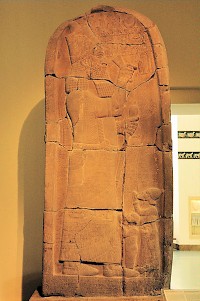Esarhaddon's Prism B
Tyre (Phoenician רצ, ṣūr, "rock"; Greek Τύρος; Latin Tyrus): port in Phoenicia and one of the main cities in the eastern Mediterranean.

In the first quarter of the seventh century BCE, the Assyrian king Esarhaddon (r.680-669) tightened the Assyrian grip on the cities of Phoenicia. Sidon was sacked in 677/676 and its people were deported. In the next year, 676/675, the cities of Syria and Cyprus were ordered to contribute building materials for a monument in Nineveh.
The inscription mentions two groups of contributing kings: those ruling over the Levantine cities and those ruling the colonies in the west. It also mentions their tributes. The text has attracted considerable attention because it also mentions King Manasseh of Judah, who ruled from 687 to 642. It is interesting to notice that in this list, Sidon is absent.
The translation is by Leo Oppenheim and can be found in ANET3 291.
Esarhaddon's Prism B
[1] I called up the kings of the country Hatti and (of the region) on the other side of the river Euphrates: Ba'al, king of Tyre; Manasseh, king of Judah; Qawsgabar, king of Edom; Musuri, king of Moab; Sil-Bel, king of Gaza; Metinti, king of Ashkelon; Ikausu, king of Ekron; Milkiashapa, king of Byblos; Matanba’al, king of Arvad; Abiba'al, king of Samisimuruna; Puduil, king of Beth-Ammon; Ahimilki, king of Ashdod
[2] - twelve kings from the seacoast.
[3] Ekishtura, king of Edi’il;note Pilagura, king of Kitrusi;note Kisu, king of Sillu’ua;note Ituandar, king of Pappa;note Erisu, king of Silli;note Damasu, king of Kuri;note Atmesu, king of Tamesi;note Damusi, king of Qarti-hadasti;note Unasagusu, king of Lidir;note Bususu, king of Nuria;note
[4] - ten kings from Cyprus amidst the sea.
[5] Together twenty-two kings of Hatti, the seashore, and the islands. All these I sent out and made them transport under terrible difficulties, to Nineveh, the town of my rulership, as building material for my palace: big logs, long beams and thin boards from cedar and pine trees, products of the Sirara and Lebanon mountains, which had grown for a long time into tall and strong timber, also from their quarries in the mountains, statues of Lamassu and Shedu protective dieties made of ašnan stone, statues of abzaztu, thresholds, slabs of limestone, of ašnan stone, of large and small grained breccia, of alallu-stone and of gi.rin.hi.li.ba-stone.